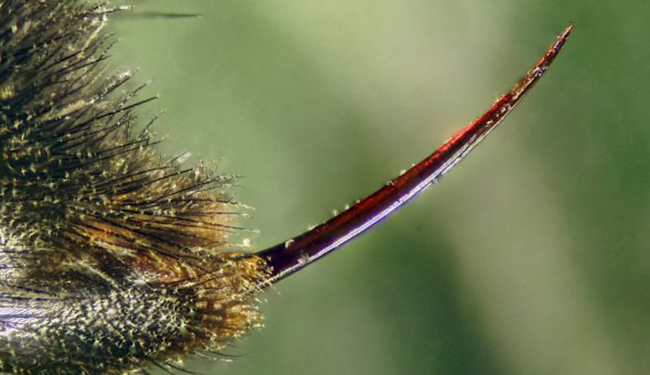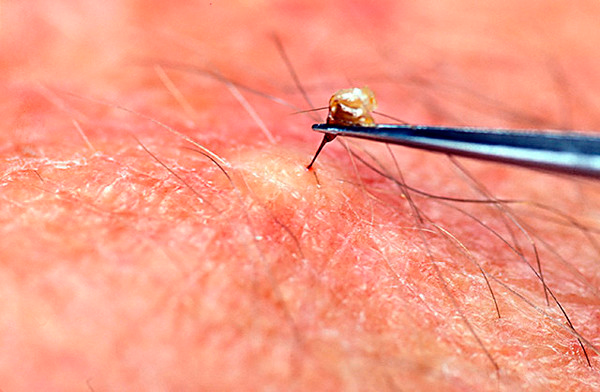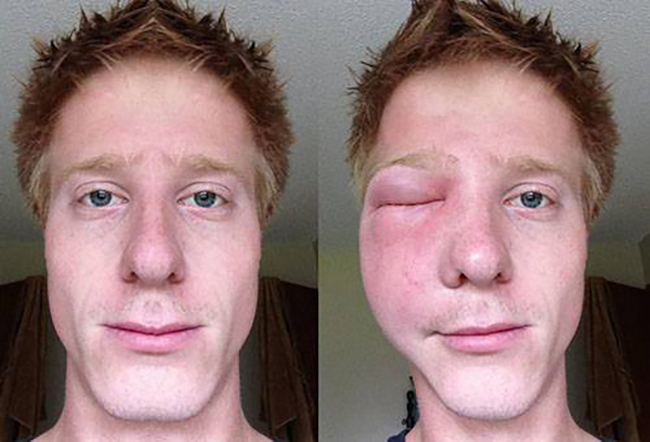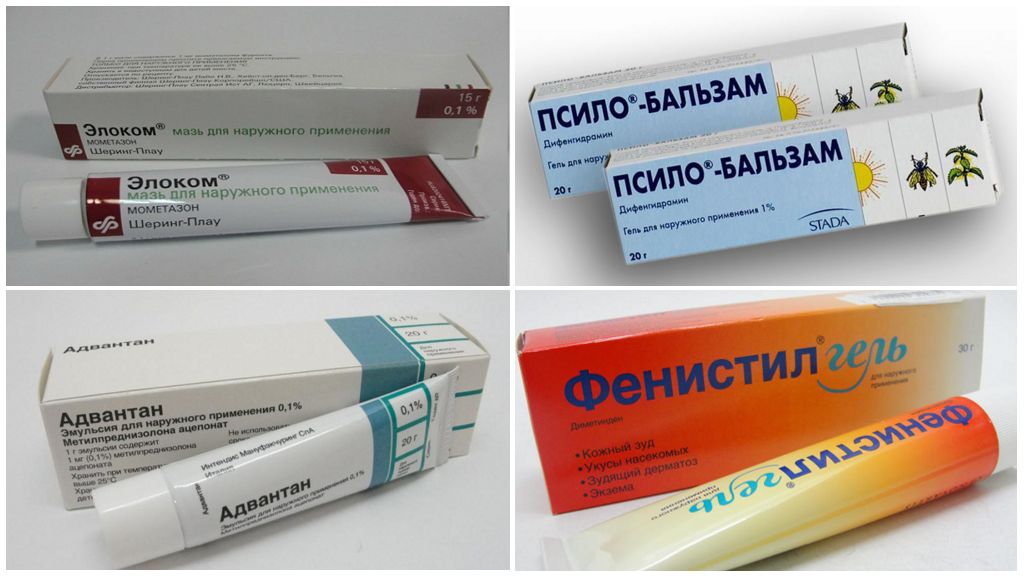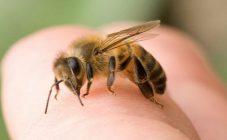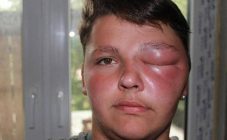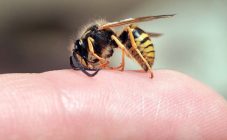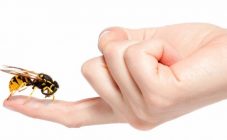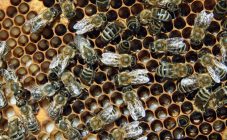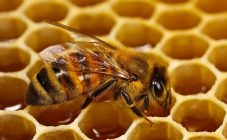Content:
A bee sting is classified as a defense organ and is part of the body of worker bees and queens only. The sting has a pointed shape. This organ, in the process of being stung by a bee, injects a burning and poisonous substance under the skin. This process occurs exclusively in the worker bee, the queens use the sting to lay eggs.
Where is the sting of a bee
The bee sting is located at the end of the abdomen of the insect and is used solely for the purpose of protection. The bee never attacks itself unless it senses danger. Since the abdominal structure of the insect is flexible, the blow is always delivered accurately. The sting penetrates under the skin, thanks to notches, which can only be seen under a microscope.
At the moment of penetration of the sting into the skin, 0.3 mg of the poison enters the body. Due to its poisonous glands, the sting, after being pierced into the skin, continues to act for a long time. Therefore, it is required to remove it as soon as possible.
After striking a blow, not only the one who was stung by the insect suffers, but also the bee itself. Since she immediately forms an open wound, which becomes the cause of death of the insect.
What a bee sting looks like after being bitten
During contact with the enemy, the bee defends itself and stings. Preparing for an attack, the insect lowers and bends its abdomen, then exposes part of the sting. After the sting, when the insect tries to fly away, the sting detaches, since the notches do not release it from the body.
Structurally, the sting looks like two elongated stylets that protrude from the abdomen along special formations. These formations in the calm state of the insect at the posterior end of the body are closed with special plates that move apart at the moment of attack.
If the sting remains in the skin after the bite
Not a single person is immune from a bee sting. Most often, insects sting in July and August. The poison that enters the human body during a sting has a diverse effect and is undoubtedly toxic.
During the bite, unpleasant, painful sensations and burning sensations occur. After that, the bite site turns red and begins to swell. If a person suffers from an allergic reaction, then the consequences of a bite can be unpredictable. Many do not imagine what a sting looks like in bees, and have no idea about its features. This leads to improper behavior after being bitten.
If a bee stung, then the person first needs to leave the site of the attack. In this case, you should not try to kill the bee, especially if it is not alone. Aggressive behavior on the part of a person can provoke another attack.
If a sting remains after a bee sting, you need to act immediately, since it contains, in addition to the poison, a certain amount of bacteria, so you must immediately treat the affected area with an antiseptic. This is due to the fact that the organ has many small notches, and the insect, after being stung, cannot pull it out.
How to remove a sting at home
After a bee sting, remove the sting as soon as possible. Many people try to extract it with their fingers.It is not recommended to squeeze it out, especially if the affected area is sensitive. This is argued by the fact that during squeezing out the poison in the body spreads several times faster. It is best to remove the sting with tweezers or a needle. This should be done as carefully as possible, since even a slight violation of the integrity of the skin is a potential conduit for infection. Particular attention should be paid to the process of extracting the tip. You need to grab it with tweezers near the skin itself, then just drag it. It is important to grab the sting below the bag of poison, otherwise all the poison in it will enter the body.
If one bee has bitten, nothing can be done with the sting, provided that the person is not allergic to bee venom. In this case, a person may not feel pain at all and simply forget about the sting. After a bite, a small abscess will form on the affected area, with which the sting will come out by itself.
If several bees have stung, then after removing the sting, a person should consume as much liquid as possible to remove the poison as soon as possible. The most useful drinks in this situation are compotes, herbal teas, and water with honey dissolved in it. It is strictly forbidden to consume hot tea and alcoholic beverages.
To relieve puffiness, a cold compress must be applied to the affected area. It is strictly forbidden to scratch the bite site. If the itching is severe, then in this case, the affected area should be treated with an ointment, the active ingredient of which is hydrocortisone.
In case of increased susceptibility to bee venom, you should immediately seek medical help.
This also applies to the following situations:
- with a massive attack of bees;
- if the bite was made in the head or neck area;
- with a bite of the mucous membranes, mouth and eyes.
Treatment of the effects of a bite
In some situations, a bee sting can provoke unwanted consequences, such as the development of a tumor or an allergic reaction. Most often, such consequences are observed in allergy sufferers, but pregnant women and children are also at risk. If you react correctly and take the necessary measures, you can minimize discomfort and prevent the development of complications.
The most common consequence of a bee sting is swelling. Folk remedies will help to remove it. You can apply a soda compress to the affected area, make a cold lotion prepared on the basis of ammonia or hydrogen peroxide. It also effectively relieves swelling and neutralizes swelling with a compress of dissolved aspirin. Beekeepers use honey and garlic to rub the bite site. If the tumor does not go away for a long time, then antihistamines will help.
The presence of an allergic reaction after a bite is manifested by the following symptoms:
- chills;
- violation of the heart rhythm;
- an increase in body temperature;
- the appearance of urticaria;
- severe itching;
- drowsiness;
- the occurrence of spasms and swelling of the mucous membranes.
In the presence of an allergy or the appearance of minor signs of it, the victim needs to immediately inject a solution of suprastin or pipolfen intramuscularly and call emergency help. Further treatment is carried out only in stationary conditions.
If you don't pull out the sting of the bee
As soon as the sting of the bee enters the skin, piercing and the formation of a wound occurs, into which the toxic substance penetrates. If you do not immediately pull out the sting, then poison begins to gradually come out of the weapon. The longer this insect defense organ is in the skin, the more poison is released from it, respectively, toxins accumulate in the body.
It has been scientifically proven that the introduced poison can be emptied from the sting as much as possible within 30 minutes. The older the bee, the greater the amount of poison. In these insects, poison begins to accumulate intensively, starting from the second day of life. By the sixteenth day, the glands are completely filled, and the insect is ready to fully defend itself and its family members.
The use of a sting by a bee allows it to protect its family and home. Bees never attack or sting unless they feel fear and threat. If the sting nevertheless occurs, you must immediately take all the necessary measures to ensure that as little poison as possible penetrates the body. Only timely and correct actions will help to avoid unpleasant consequences.
